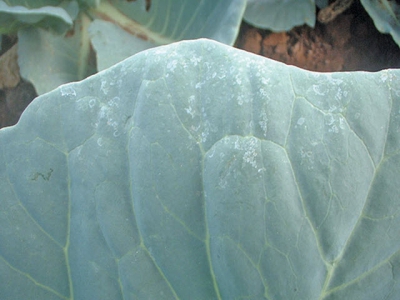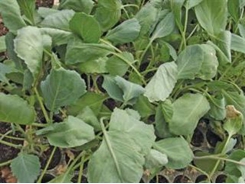Understanding spray mixtures

With spray adjuvants, many farmers think that mixing a sticker and a wetter/spreader into the water are the same thing. This is certainly not true.
Deposits on leaves left by water with a high mineral content will rapidly neutralise crop chemicals. Photo: Bill Kerr
A sticker ensures the sprayed product ‘sticks’ to the plant and prevents it from being washed off for a period.
If you use a sticker while spraying crops with waxy leaves such as cabbages or onions, virtually all the spray mixture will slide off the leaves and end up in the soil.
Here, you need a wetter, which breaks down surface tension on waxy plants and allows the droplets of spray to ‘wet’ the plant thoroughly.
In other words, stickers and wetters/spreaders must be used for their intended purpose.
On some occasions you need only one, on others both. Some can be bought as a combination, but I prefer to separate the products as this allows for versatility.
When spraying an easy-to-wet crop such as tomatoes, a wetter is unnecessary. If the right size droplets are applied, the plant will be easily wetted. This saves you money and probably works better than a wetter.
However, if you have outdoor tomatoes and are spraying prophylactic products such as copper or dithiocarbamates, which coat the leaf surface and protect the plant from pathogens, you’ll want to keep the product ‘in place’ for as long as possible.
So you will need a sticker.
(With tomatoes in a tunnel, there’s no risk of the product washing off, so a sticker isn’t needed.)
When applying systemic products that are absorbed into the leaf, you need a wetter on crops that require it, as the product doesn’t remain on the leaf surface and a sticker is thus more likely to be a hindrance than a benefit.
Buffers
Another product which is also sometimes confused with wetters and stickers is a buffer. This important adjuvant keeps the crop chemical from breaking down when mixed with water.
If this happens, the chemical can become less effective when the water pH is above a certain level. (Most products work best at a pH of about 4, but this needs to be checked with the product supplier.)
The water’s mineral content can also have the same effect. The buffer is the first product you add to the water in the spray tank. A good buffer will change the colour of the water to indicate when it has made the water less damaging to the applied chemical.
Ammonium sulphate
On the label of the herbicide glyphosate you’ll sometimes see it’s recommended that you apply 500g of ammonium sulphate to 100l water before adding the product.
In this case the ammonium sulphate causes the minerals in the water to combine with it rather than with the glyphosate, which would reduce the herbicide’s efficacy.
From the foregoing it should be clear that water quality plays an important role in how well our expensive crop chemicals will work. Water which is dirty from rain washing into a dam or stream is bad news.
The dirt is mostly clay, which will absorb – and neutralise – many crop chemicals. For example, if you accidentally ingest paraquat, which has no antidote, you have to ‘eat’ clay as soon as possible to tie up the toxin.
Neglected
Another hindrance to the efficacy of most crop chemicals is minerals in irrigation water – especially when it comes from a borehole.
These minerals can accumulate on leaf surfaces during dry, hot weather – an unseen layer which renders the crop chemical useless.
I have no idea how this can be prevented – perhaps by adding ammonium sulphate before spraying? Perhaps a chemist could come up with the answer, and contact me.
Có thể bạn quan tâm
Phần mềm

Phối trộn thức ăn chăn nuôi

Pha dung dịch thủy canh

Định mức cho tôm ăn

Phối trộn phân bón NPK

Xác định tỷ lệ tôm sống

Chuyển đổi đơn vị phân bón

Xác định công suất sục khí

Chuyển đổi đơn vị tôm

Tính diện tích nhà kính

Tính thể tích ao hồ



 Growing Brussels sprouts
Growing Brussels sprouts  How to harden seedlings
How to harden seedlings